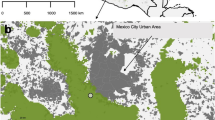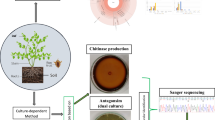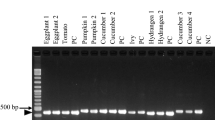Abstract
The fate of a biocontrol agent released on pine phyllosphere in a greenhouse-confined trial was followed over 102 days. The microorganism used, a Pseudomonas sp., isolated from Pinus nigra, carries the cry9a toxin gene from Bacillus thuringiensis. In order to detect the GMM, specific primers were used, and a previously defined protocol for DNA isolation from bacteria colonizing pine needles was applied. The method, based on vortexing in a suspension of glass beads followed by microcolumn extractions, allowed sensitive PCR monitoring of the target transgenes. The presence of the released organism was recorded throughout the trial and compared with its entomocidal performance towards larvae of the pine processionary caterpillar Thaumetopoea pityocampa. At the same time the dynamics of the released Pseudomonas within the whole epiphytic bacterial community, was followed by amplifying 16S rDNA pools and comparing ARDRA profiles at seven sampling points. The resulting dendrogram allowed to follow the time-dependent progressive blending of the Pseudomonas profile into those of the resident biota. PCR-dominance of the released bacterium in the community was extended until 21 days from release while its activity against insect larvae lasted for over 3 months. The prokaryotic epiphytic population, irrespective of any particular impact from the released strain, showed no resilience but a general successional trend, which, remarkably, appeared synchronous on all trees tested, including non-inoculated controls. This observation suggests interesting patterns of concerted environmental shifts by phyllospheric microorganisms.

Similar content being viewed by others
References
Alberghini S, Filippini R, Marchetti E, Dindo ML, Shevelev AB, Battisti A et al (2005) Construction of a Pseudomonas sp. derivative carrying the Cry9Aa gene from Bacillus thuringiensis and proposal of new standard criteria to assess entomocidal properties of bacteria. Res Microbiol 156:690–699. doi:10.1016/j.resmic.2005.02.003
Alberghini S, Filippini R, Shevelev AB, Battisti A, Squartini A (2006) Extended plant protection by an epiphytic Pseudomonas sp. derivative carrying the cry9Aa gene from Bacillus thuringiensis galleriae against the pine processionary moth Thaumetopoea pityocampa. Biocontrol Sci Technol 16:709–715. doi:10.1080/09583150600699960
Alberghini S, Battisti A, Squartini A (2008) Methods and detection limits in tracking a genetically modified Pseudomonas sp. released in the pine phyllosphere. Ann Microbiol 58:163–167
Corich V, Giacomini A, Basaglia M, Vendramin E, Vian P, Carlot M et al (2001) Aspects of marker/reporter stability and selectivity in soil microbiology. Microb Ecol 41:333–340
Corich V, Giacomini A, Vendramin E, Vian P, Carlot M, Concheri G et al (2007) Long term evaluation of field-released genetically modified rhizobia. Environ Biosafety Res 6:167–181. doi:10.1051/ebr:2007006
Cullen DW, Nicholson PS, Mendum TA, Hirsch PR (1998) Monitoring genetically-modified rhizobia in field soils using the polymerase chain reaction. J Appl Microbiol 84:1025–1034. doi:10.1046/j.1365-2672.1998.00443.x
Donegan K, Matyac C, Seidler R, Porteous A (1991) Evaluation of methods for sampling, recovery, and enumeration of bacteria applied to the phylloplane. Appl Environ Microbiol 57:51–56
Giacomini A, Ollero FJ, Squartini A, Nuti MP (1994) Construction of multipurpose gene cartridges based on a novel synthetic promoter for high-level gene expression in Gram-negative bacteria. Gene 144:17–24. doi:10.1016/0378-1119(94)90197-X
Hirsch PR (1996) Population dynamics of indigenous and genetically modified rhizobia in the field. New Phytol 133:159–171. doi:10.1111/j.1469-8137.1996.tb04351.x
Jansson J, Van Elsas JD, Bailey M (eds) (2000) Tracking genetically engineered microorganisms. Landes Biosciences, Georgetown, TX, USA
Lindow SE, Brandl MT (2003) Microbiology of the Phyllosphere. Appl Environ Microbiol 69:1875–1883. doi:10.1128/AEM.69.4.1875-1883.2003
Marchesi JR, Sato T, Weightman AJ, Martin TA, Fry JC, Hiom SJ et al (1998) Design and evaluation of useful bacterium-specific PCR primers that amplify genes coding for bacterial 16S rRNA. Appl Environ Microbiol 64:795–799
Miethling R, Tebbe C (2004) Resilience of a soil-established, genetically modified Sinorhizobium meliloti inoculant to soil management practices. Appl Soil Ecol 25:161–167. doi:10.1016/j.apsoil.2003.08.003
Naseby DC, Lynch JM (1998) Impact of wild type and genetically modified Pseudomonas fluorescens on soil enzyme activities and microbial population structure in the rhizosphere of pea. Mol Ecol 7:617–625. doi:10.1046/j.1365-294x.1998.00367.x
Nuti MP, Squartini A, Giacomini A (1994) European Community regulation for the use and release of genetically modified organisms (GMOs) in the environment. In: O’Gara F, Dowling D, Boesten B (eds) Molecular ecology of rhizosphere microorganisms. VCH Publ, Weinheim, Germany, pp 165–173
Nuti MP, Russo A, Toffanin A, Casella S, Corich V, Squartini A et al (2003) What did we learn from 24 field releases of GMMs in Italy? In: Lelley T, Balasz E, Tepfer M (eds) Ecological impact of GMO dissemination in agro-ecosystems. Facultas Verlags, Vienna, pp 45–54
Osborn AM, Moore ERB, Timmis KN (2000) An evaluation of terminal-restriction fragment length polymorphism (T-RFLP) analysis for the study of microbial community structure and dynamics. Environ Microbiol 2:39–50. doi:10.1046/j.1462-2920.2000.00081.x
Seligy VL, Beggs RW, Rancourt JM, Tayabali AF (1997) Quantitative bioreduction assays for calibrating spore content and viability of commercial Bacillus thuringiensis insecticides. J Ind Microbiol Biotechnol 18:370–378. doi:10.1038/sj.jim.2900404
Stastny M, Battisti A, Petrucco-Toffolo E, Schlyter F, Larsson S (2006) Host-plant use in the range expansion of the pine processionary moth, Thaumetopoea pityocampa. Ecol Entomol 31:481–490. doi:10.1111/j.1365-2311.2006.00807.x
Thompson IP, Ellis RJ, Bailey MJ (1995a) Autecology of a genetically modified fluorescent Pseudomonad on sugar beet. FEMS Microbiol Ecol 17:1–13. doi:10.1111/j.1574-6941.1995.tb00122.x
Thompson IP, Lilley AK, Ellis RJ, Bramwell PA, Bailey MJ (1995b) Survival, colonization and dispersal of genetically modified Pseudomonas fluorescens SBW25 in the phytosphere of field grown sugar beet. Biotechnology (NY) 13:1493–1497. doi:10.1038/nbt1295-1493
van Veen JA, van Overbeek LS, van Elsas JD (1997) Fate and activity of microorganisms introduced into soil. Microbiol Mol Biol Rev 61:121–135
Walter MV, Marthi B, Fieland VP, Ganio LM (1990) Effect of aerosolization on subsequent bacterial survival. Appl Environ Microbiol 56:3468–3472
Yoshimura F (1982) Phylloplane bacteria in a pine forest. Can J Microbiol 28:580–592
Zhang B, Bai Z, Hoefel D, Tang L, Yang Z, Zhuang G et al (2008) Assessing the impact of the biological control agent Bacillus thuringiensis on the indigenous microbial community within the pepper plant phyllosphere. FEMS Microbiol Lett . doi:10.1111/j.1574-6968.2008.01178.x
Acknowledgments
Sara Alberghini was the recipient of a post-doctoral grant from the University of Padova. This work was supported in part by an Italian National MURST-PRIN Grant and by funds from the Veneto Region Forest Protection Project.
Author information
Authors and Affiliations
Corresponding author
Rights and permissions
About this article
Cite this article
Alberghini, S., Battisti, A. & Squartini, A. Monitoring a genetically modified Pseudomonas sp. released on pine leaves reveals concerted successional patterns of the bacterial phyllospheric community. Antonie van Leeuwenhoek 94, 415–422 (2008). https://doi.org/10.1007/s10482-008-9259-6
Received:
Accepted:
Published:
Issue Date:
DOI: https://doi.org/10.1007/s10482-008-9259-6




